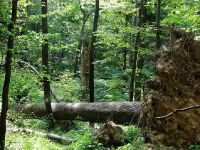| Kolor szlaku | |
| Nazwa szlaku | PTTK Kuźniaki – Gołoszyce |
| Długość | 105 km |
| Odcinek w granicach ŚPN | Święta Katarzyna – Trzcianka |
| Długość odcinka i czas przejścia |
18,8 km, 7h. |
| Rodzaj szlaku | Pieszy |
| Informacja o cenach | Szlak płatny |

It is in this village that the trail enters the Świętokrzyski National Park. Having passed the entrance gate, we reach the Saint Francis Spring, whose water is said to have healing properties; it helps especially people suffering from different kinds of eye diseases. Next to the Spring there is a chapel of Saint Francis, who is the Patron Saint not only of blind people but also of ecologists.
We start a quite steep climb of about 2.5 kilometres, and after almost an hour we reach Łysica (613 metres above sea level), the highest summit of the Łysogóry range and the entire Świętokrzyskie mountains. From the top, we can observe outcrops and boulder fields which are called gołoborza and constitute one of the greatest attractions of the ŚNP. Built of 500-million-year-old quartz sandstone blocks, gołoborza form picturesque, almost bare fields, which are being slowly but systematically overgrown with forest vegetation.
Walking on the ridge of the Łysogóry range, we pass the peak of Agata (613,96 metres above sea level) with gołoborze, and after about 3 kilometres we reach a wooden chapel of Saint Nicholas, which was meant to protect wanderers against wild animals. Here starts the blue trail to Wał Małacentowski via the Bieliny village.
We descend from the ridge towards the Kakonin village. The trail leaves the ŚNP at the forest border. At this point, noteworthy is the panorama of the southern Łysogóry as well as a historic cottage, built in the regional style in the first half of the nineteenth century.
In the village of Dalianka we enter the ŚNP again. From now on we move along the forest edge, admiring the nature of the Łysogóry range on the one side, and the beautiful view of Wał Małacentoeski and the Orłowiński range on the other. We pass villages such as Huta Podłysica, Huta Szklana, Stara Huta, and Nowa Huta. All of them used to be famous for glass sculpture in the 17th and 18th centuries. Hence, the names of these villages include the word

